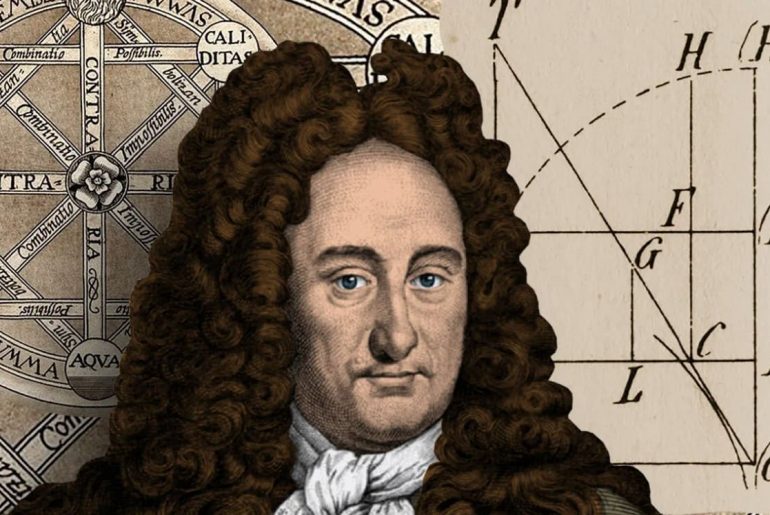GOTTFRIED WILHELM BARON VON LEIBNIZ was a philosopher, historian, lawyer and mathematician. He is considered the last universal genius of modern times. He was undisputedly one of the greatest German thinkers. Duke GEORG LUDWIG called it the “living encyclopedia”. The sentence has been handed down from him:
“When I woke up I had so many ideas that I didn’t have enough time to write them down in one day.”
Life and work
LEIBNIZ was born in Leipzig on July 1, 1646. His father FRIEDRICH LEIBNIZ was a law professor and his mother was the daughter of a professor. His parents died young (1652 and 1664 respectively). LEIBNIZ learned to read at the age of four and taught himself Latin at the age of eight, which he mastered perfectly a few years later. He himself reported about his childhood:
“Growing up, I found reading stories immensely enjoyable. When I was a boy I loved history and poetry, notitiam rei literariüae, instead of games.”
At the age of 17 he passed his first philosophical examination and at the age of 18 he received his master’s degree. During his studies, he worked with
- philosophy
- jurisprudence
- mathematics
- logic
- physics
- alchemy
In addition, his life’s work impresses with his occupation with
- politics
- linguistics
- theology
- story
- geology
- Technology
LEIBNIZ received his doctorate in 1666 (at the age of 20) in Altdorf near Nuremberg for a doctorate in both laws (secular and canon law) and then embarked on a legal career in Leipzig. As early as 1669 he had become a foreign member of the Paris “Académie des Sciences”. In 1673 the Royal Society (London Academy) accepted him as a member. At the age of 29, LEIBNIZ discovered the infinitesimal calculus (infinity calculus).
From 1670 he worked as a councilor at the Electoral Court of Appeal in the Electorate of Mainz. From a very early age he was interested in mathematical and engineering problems. His leitmotif was THEORIA CUM PRAXI. In addition to pioneering work on infinitesimal calculus, LEIBNIZ has made several technical inventions.
From 1676 he was appointed privy councilor and senior librarian in Hanover. His stepped roller calculator was developed during this period. This mechanical system allowed the tens carry and the storage of a summand during addition and thus the repeated addition, with which the multiplication could be carried out. When the calculator was presented in London in 1672, in addition to the four basic arithmetic operations (four species calculator), it was also possible to exponentiate and extract the 2nd and 3rd roots. From 1685 he began to write a history of the ruling house of the Guelphs in Hanover. He carried out this task reluctantly, but with such diligence and thoroughness that he is considered by many to be the father of scientific historiography. In 1691 LEIBNIZ took over the management of the Wolfenbüttel library. He suggested the founding of a science center based on the French and English models and became president of the Berlin Society of Sciences in 1700. From this emerged today’s Berlin-Brandenburg Academy of Sciences. In 1711 LEIBNIZ and PETER THE GREAT met for the first time. The tsar attended the celebrations for a wedding in Torgau on the Elbe, then in Saxony, and LEIBNIZ managed to ask for an audience. There he presented the tsar with a reform program for Russia, which he accepted with interest. The tsar bestowed on him the title of Russian Secret Judicial Council. In 1713 he was appointed Imperial Court Councilor in Vienna.
The last years of LEIBNIZ – he died on November 14, 1716 in Hanover – were overshadowed by the priority dispute with ISAAC NEWTON.
LEIBNIZ recognized that the dual system is more suitable for computing than the decimal system and in 1676 designed a dual spherical calculator, which is described in a document from 1679.
LEIBNIZ wrote in the field of philosophy
- New experiments on human understanding (1703),
- Theodicy (“Essais de theodicée sur la bonté de Dieu, la liberté de l’homme et l’origine du mal” 1710) and
- Monadology (“La monadologie”, 1714).
How does Leibniz see God?
Because Leibniz assumes that God created the world and its natural laws, but no longer intervenes in them. God no longer governs the world in an enigmatic way, so that humanity is morally responsible for what is happening around it.
In which language did Leibniz write?
LEIBNIZ learned to read at the age of four and taught himself Latin at the age of eight, which he mastered perfectly a few years later. Of his own childhood, he said: “Growing up, I found reading stories exceedingly enjoyable.
How does Leibniz justify God?
Leibniz justifies suffering in general by describing that God had to create the world imperfectly and therefore human beings are finite in their minds and limited in their possibilities of action. Human imperfections result in natural and moral evils.
What is moral evil?
He describes suffering as physical evil and sin or guilt as moral evil. Immanuel Kant emphasizes that the Latin language only knows the term malum, while the German conceptually differentiates between evil and evil.
Can God Suffer?
Can God suffer? is a quote from the Hegel book H. Ktings. The question formulates a basic concern of modern theology and at the same time points – even if H.
Why does God allow suffering?
In turn, suffering in this necessarily imperfect world is not part of the act of creation, but an inevitable consequence of human choice between good and evil. For the sake of this willed freedom, God only allows unwanted suffering.
Is God Almighty?
Three main meanings can be distinguished: God can do absolutely everything, for him there are not only no conceivable limitations of action, but no limitations at all, i. i.e. he can also understand the laws of nature and the laws of logic (e.g.
What is meant by God?
As a god (female: goddess) or deity, a supernatural being is usually referred to, which has a great and not scientifically describable transcendent power.
What was Gottfried Wilhelm Leibniz famous for?
Leibniz is famous for being arguably the last polymath in history; for being, with Descartes and Spinoza, one of the three great representatives of early modern rationalism; for being, with Sir Isaac Newton, a coinventor of the calculus; and for advancing the much-derided view that the actual world is the “best of all”
What is Leibniz’s theory?
Leibnizian Minds and Mental States. Leibniz is a panpsychist: he believes that everything, including plants and inanimate objects, has a mind or something analogous to a mind. More specifically, he holds that in all things there are simple, immaterial, mind-like substances that perceive the world around them.
Why Gottfried Leibniz is the father of calculus?
Yes, Leibniz should be considered the founder of calculus because he was the first to publish his work in the field, his notation is essentially that of modern calculus, and his version is that which was most widely disseminated.





